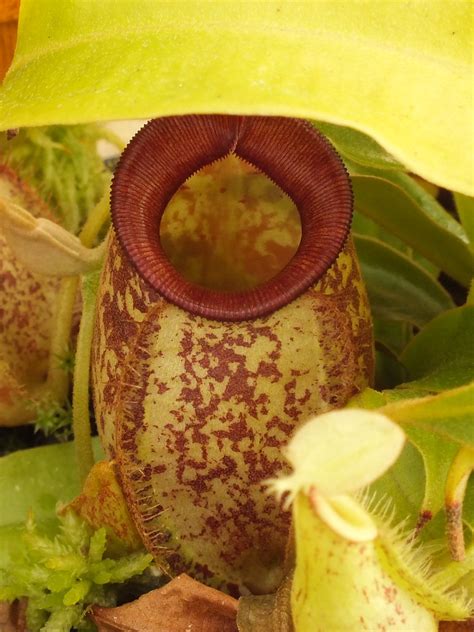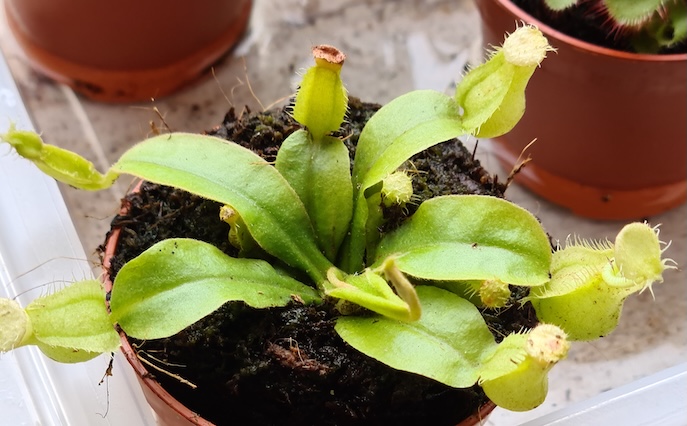

Nepenthes x 'Hookeriana'
General
Nepenthes x 'Hookeriana' is a naturally occurring hybrid tropical pitcher plant, resulting from the cross between Nepenthes ampullaria and Nepenthes rafflesiana. Highly regarded by carnivorous plant enthusiasts, it is famous for its vigor, adaptable nature, and visually captivating pitchers. This hybrid unites the distinctive features of both parents, often displaying a fascinating variety in size, coloration, and morphology. It is well-suited to both beginners and experienced collectors seeking an attractive Nepenthes with less demanding care requirements.
Physical Characteristics
This plant produces striking, jug-shaped pitchers that can range from squat, rounded forms (reminiscent of N. ampullaria) to more elongated shapes (similar to N. rafflesiana), often reaching 10–15 cm in length. The coloration is highly variable: pitchers may be green, red, speckled, or even a blend, frequently adorned with flecks or striped peristomes. The leaves are bright green and oblong, with a tendency toward a vigorous, bushy growth habit. Vines can sprawl for several feet, making it a lush and attractive specimen in any tropical collection.
Lifestyle
As a carnivorous plant, this hybrid supplements its nutrient intake by trapping and digesting insects (and occasionally other small prey) in its pitchers. Nectar secreted along the peristome and lid lures the prey, which then slips into the enzyme-laden fluid inside the pitcher, where digestion occurs. Unlike some other Nepenthes, this hybrid is also known to trap leaf litter as a secondary nutrient source, reflecting its N. ampullaria heritage.
Habitat and Protection
In the wild, this hybrid is native to the peat swamp forests and lowland areas of Borneo, Sumatra, and Peninsular Malaysia, often found in humid, shaded locations with dappled sunlight. It generally grows in acidic, nutrient-poor soils amongst mosses and decaying leaf material. As most Nepenthes are protected in their native habitats due to habitat loss, illegal collection from the wild is discouraged; always source plants from reputable nurseries that propagate through tissue culture or cuttings.
Cultivation
Thriving in controlled environments, this hybrid adapts well to terrariums, greenhouses, or warm, humid windowsills. Due to its hybrid vigor, it is more tolerant of varying conditions than many pure species. Consistency—especially regarding humidity and water quality—is key to maintaining healthy, colorful pitchers.
Special Features
What makes this hybrid stand out is its remarkable resilience and variability. Some individuals emphasize the tubby, ground-hugging pitchers of N. ampullaria, while others inherit tall, elegant forms from N. rafflesiana. Flowering occurs on long inflorescences and, as with all Nepenthes, plants are individually male or female. The ability to trap both insects and detritus makes its nutrient strategy quite versatile for a carnivorous plant.
Care
Light
Provide bright, filtered light. It thrives with several hours of dappled sun or bright indirect light daily. Direct midday sun can scorch leaves but morning or late afternoon sun is generally well tolerated.
Temperature
As a lowland hybrid, it prefers warm conditions: daytime temperatures between 77–90°F (25–32°C), with nighttime lows not dropping below 65°F (18°C). Sudden temperature drops can stress the plant.
Water
Always use soft water: rainwater, distilled, or reverse osmosis is ideal. Keep the substrate lightly moist at all times, but avoid waterlogging which can cause root rot. Reduce watering in cool, cloudy spells.
Soil
Use an open, acidic, and well-draining mix: sphagnum moss with perlite or orchid bark is excellent. Compost and nutrient-rich soils should be avoided as they promote root rot and reduce pitcher formation.
Nutrition
Frequent feeding is unnecessary. Occasional small insects or dried bloodworms can be offered if the plant is grown indoors and doesn't catch its own prey. Avoid fertilizers, as they can harm roots and pitchers.
Humidity
Maintaining high humidity (>60%) is crucial for vibrant pitchers and vigorous growth. Daily misting or a humidity tray will help in drier homes. Terrariums or grow tents make this easy if you live in an arid environment.
Dormancy
Nepenthes x 'Hookeriana' does not require a dormancy period. It grows year-round if given steady warmth and humidity. Allowing it to dry out or cool excessively can severely damage or kill the plant.
Common Problems
Pitchers fail to form
Cause: Low humidity or insufficient light.
Solution: Increase air moisture with regular misting and ensure the plant receives bright, filtered light.
Pitcher fluid dries out
Cause: Low humidity or insufficient watering.
Solution: Raise local humidity; gently top up pitchers with distilled water if necessary, being careful not to overfill.
Stunted growth
Cause: Poor water quality (tap water), or compacted/incorrect soil.
Solution: Always use mineral-free water and a loose, airy substrate.
Blackening leaves or pitchers
Cause: Sudden drops in temperature or exposure to drafts.
Solution: Confirm the growing location remains warm and free from cold breezes or sharp fluctuations.
